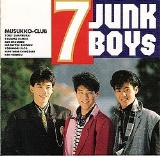
Musukko Club
Encyclopedia
was a short-lived male spin-off idol group of Onyanko Club
. They made their debut in 1986 with the song Chotto Karai Aitsu (an ending theme song for High School! Kimengumi
), and broke up after their February 15, 1987 concert at Nippon Budokan
. The seven members of the group were Ken Iwashiro, Shūsuke Namiki, Yoshinori Satō
, Yōji Sawamukai, Kō Shimizu, Hirotoshi Shinozaki and Hiromitsu Shizuku.
A CD
by the same title was released as well, with one extra track:
, 30 minutes, ¥4500
This video of their final concert features the following songs:
Onyanko Club
was a large all-girl Japanese pop idol group in the 1980s. The group gave a new approach to the idol formula with its 52 official members and three unofficial members...
. They made their debut in 1986 with the song Chotto Karai Aitsu (an ending theme song for High School! Kimengumi
High School! Kimengumi
is a manga series written by Motoei Shinzawa which ran in Weekly Shōnen Jump from 1982 to 1987. The title literally translates to High School! Funny-face Club or High School! Weird Face Club. An anime TV series and movie based on the series were also released...
), and broke up after their February 15, 1987 concert at Nippon Budokan
Nippon Budokan
The , often shortened to simply Budokan, is an indoor arena in central Tokyo, Japan.This is the location where many "Live at the Budokan" albums were recorded...
. The seven members of the group were Ken Iwashiro, Shūsuke Namiki, Yoshinori Satō
Yoshinori Sato
is a Japanese professional baseball player. He is a starting pitcher for the Tokyo Yakult Swallows.Sato clocked some of the fastest speeds in tournament history with his fastball when he pitched in the 89th National High School Baseball Championship in as a senior for Sendai Ikuei Gakuen High School...
, Yōji Sawamukai, Kō Shimizu, Hirotoshi Shinozaki and Hiromitsu Shizuku.
Singles
- Boku-tachi no Season/Kanojo wa Girlfriend, Epic/Sony, 07•5H-313, SingleSingle (music)In music, a single or record single is a type of release, typically a recording of fewer tracks than an LP or a CD. This can be released for sale to the public in a variety of different formats. In most cases, the single is a song that is released separately from an album, but it can still appear...
- Chotto Karai Aitsu/Kimagure na Kimi ga Suki, Epic/Sony, 07•5H-332, Single
Albums
Songs that do not indicate a specific vocalist are sung by the entire group.- 7 Junk Boys, Epic/Sony, 28•3H-266, LPGramophone recordA gramophone record, commonly known as a phonograph record , vinyl record , or colloquially, a record, is an analog sound storage medium consisting of a flat disc with an inscribed, modulated spiral groove...
- A1. Zenryaku I Love You
- A2. Boku-tachi no Season
- A3. Meisō no Machi (Yōji Sawamukai)
- A4. Jungle Boy (Hiromitsu Shizuku)
- A5. Kanojo wa Girlfriend (Yoshinori Satō)
- A6. Ai no Mune o Hatte
- B1. Chotto Karai Aitsu
- B2. Hoshi no Dōbōsha (Ken Iwashiro)
- B3. Me-Cha-She (Shūsuke Namiki & Hirotoshi Shinozaki)
- B4. Onshitsu Sodachi no Melon-tachi (Kō Shimizu)
- B5. Kimagure na Kimi ga Suki (Yoshinori Satō)
A CD
Compact Disc
The Compact Disc is an optical disc used to store digital data. It was originally developed to store and playback sound recordings exclusively, but later expanded to encompass data storage , write-once audio and data storage , rewritable media , Video Compact Discs , Super Video Compact Discs ,...
by the same title was released as well, with one extra track:
- 7 Junk Boys, Epic/Sony, 32•8H-102, January 21, 1987, CD
-
- Zenryaku I Love You
- Boku-tachi no Season
- Meisō no Machi (Yōji Sawamukai)
- Jungle Boy (Hiromitsu Shizuku)
- Kanojo wa Girlfriend (Yoshinori Satō)
- Ai no Mune o Hatte
- Chotto Karai Aitsu
- Hoshi no Dōbōsha (Ken Iwashiro)
- Me-Cha-She (Shūsuke Namiki & Hirotoshi Shinozaki)
- Onshitsu Sodachi no Melon-tachi (Kō Shimizu)
- Kimagure na Kimi ga Suki (Yoshinori Satō)
- Kimi o Idaite Mitai (CD version of Chotto Karai Aitsu)
Video releases
7 Junk Boys, Epic/Sony, VHSVHS
The Video Home System is a consumer-level analog recording videocassette standard developed by Victor Company of Japan ....
, 30 minutes, ¥4500
This video of their final concert features the following songs:
- Boku-tachi no Season
- Zenryaku I Love You
- Meisō no Machi
- Jungle Boy
- Me-Cha-She
- Hoshi no Dōbōsha
- Onshitsu Sodachi no Melon-tachi
- Kanojo wa Girlfriend
- Boku-tachi no Season (reprise)
- Chotto Karai Aitsu

